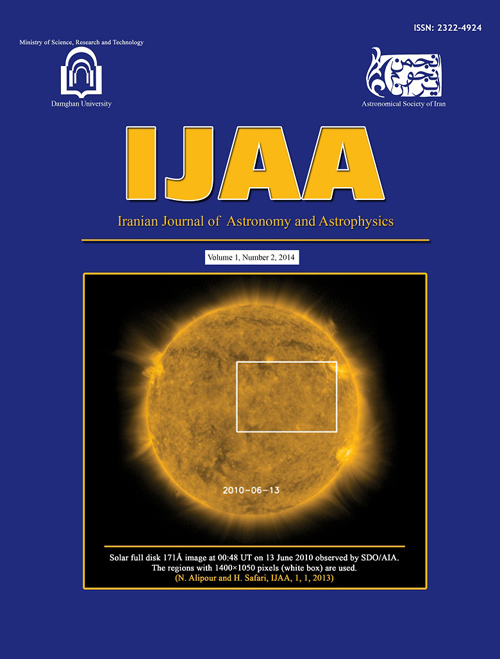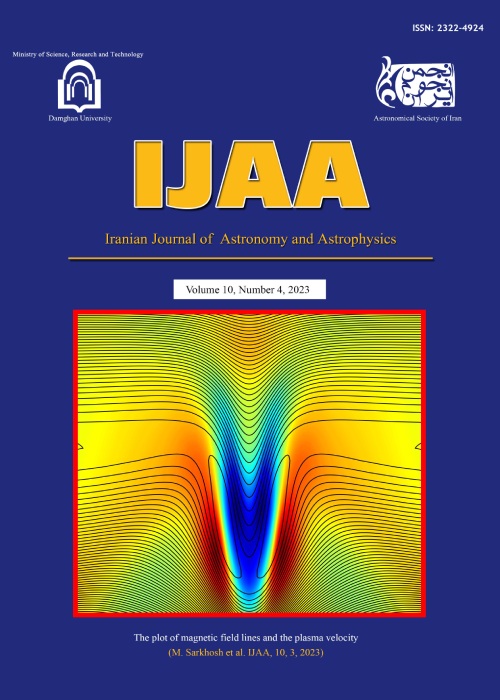فهرست مطالب

Iranian Journal of Astronomy and Astrophysic
Volume:1 Issue: 2, Autumn 2014
- تاریخ انتشار: 1394/06/23
- تعداد عناوین: 7
-
-
Pages 89-94Using the usual definitions of information and entropy in quantum gravity and statistical mechanics and the existing views about the relation between information and complexity, we examine the evolution of complexity in an ever expanding universe.Keywords: cosmic expansion, entropy of the universe, rise of complexity
-
Pages 95-107We study local stability of self-gravitating fluid and stellar disk in the context of modified gravity theories which predict a Yukawa-like term in the gravitational potential of a point mass. We investigate the effect of such a Yukawa-like term on the dynamics of self-gravitating disks. More specifically, we investigate the consequences of the presence of this term for the local stability of the self-gravitating disks. In fact, we derive a generalized version of Toomre's local stability criterion for diferentially rotating disks. This criterion is complicated than the original one in the sense that it depends on the physical properties of the disk. In the case of MOdified Gravity theory (MOG), we use the current confirmed values for the free parameters of this theory, to write the generalized Toomre's criterion in a more familiar way comparable with the Toomre's criterion. This generalized Toomre's criterion may be used to study the global stability of stellar and fluid disks using computer simulations.Keywords: Modifi ed gravity(MOG), Toomre's local stability criterion
-
Pages 109-118Alfvén waves dissipation is an extensively studied mechanism for the coronal heating problem. These waves can be generated by magnetic reconnection and propagated along the reconnected field lines. Here, we study the generation of Alfvén waves at the presence of both steady flow and sheared magnetic field in the longitudinally density stratified of solar spicules. The initial flow is assumed to be directed along the spicule axis, and the equilibrium magnetic field is taken 1-dimensional and divergence-free. We solve linearized MHD equations numerically and find that the perturbed velocity and magnetic field oscillate similarly which can be interpreted as generation and propagation of Alfvénic waves along spicule axis. The results of calculations give periods of around 25 and 70 s for these waves which are in good agreement with observations.Keywords: ISM: solar spicules, ISM: Alfvén waves, ISM: magnetic reconnection
-
Pages 119-126The dependence of the lateral distribution of Cherenkov light in simulated extensive air showers to the energy and the mass of the primary cosmic rays has been studied. It has been shown that a previous claim about mass independent proportionality of shower energy to the total Cherenkov photon number is not valid in energies below EEAS ~ 1014 eV. We have found that the core distance of the so called hump in the lateral distribution of Cherenkov light in gamma ray initiated showers is independent from shower energy. The hump disappears in showers with EEAS ≳ 1014 eV. Finally, a simple model for the lateral Cherenkov light lateral distribution has been proposed, which can be fitted to all types of cosmic ray showers. The fit parameters seem to be promising for primary cosmic ray mass discrimination.Keywords: Cosmic Rays, Extensive Air Shower, Cherenkov Radiation
-
Pages 127-137Simulation of gamma and hadron showers in the energy range 100GeV- 25TeV has been carried out. For a big ideal Cherenkov light array, characteristics of lateral distribution of Cherenkov photon density have been studied. Results from this ideal detector are compared with those simulated for a real TUNKA- like array to investigate experimental potential of using existence of a hump in lateral distribution of Cherenkov photon density for gamma-hadron separation. It is shown that by using this technique the proton rejection efficiency of %63 can be achieved in typical TUNKA-like arrays.Keywords: Cherenkov array, Lateral distribution, hump, γ, ray astronomy
-
Pages 139-149Virial theorem is important for understanding stellar structures. It produces an interesting connection between magnetic and gravitational energies. Using the general form of the virial theorem including the magnetic field (toroidal magnetic field), we may explain the solar dynamo model in relation to variations of the magnetic and gravitational energies. We emphasize the role of the gravitational energy in sub-surface layers which has been certainly minored up to now. We also consider two types of solar outer shape (spherical and spheroidal) to study the behavior of magnetic and gravitational energies. The magnetic energy affects by the solar shape, while the gravitational energy is not changed by the considered shapes of the Sun.Keywords: ISM: virial theorem, ISM: magnetic eld, rotation, gravitational energy
-
Pages 151-158Magnetic fields play an important role in creating, driving, and in the evolution of outflows and jets from protostars and accretion disks. On the other hand, the temperature profile of the accretion disks may also affect the structure of the magnetic field and outflows. In this paper, we use the self-similar method in cylindrical coordinates to investigate the effect of the temperature profile of the accretion disk (T ∝r-1/2) in the formation of jets and outflows around protostars. The results show that in each specified angular momentum, there is a critical value for the ratio of the mass flux to the magnetic flux. For values less/larger than this critical value, taking into account the temperature profile in the disk results in a broadening/collimation of the jet, respectively. Outflows, on the other hand, are always broadened when accounting for the temperature profile of the disk.Keywords: accretion discs, magnetic fields, (magnetohydrodynamics) MHD, methods: numerical, stars: protostars, ISM: jets outflows


